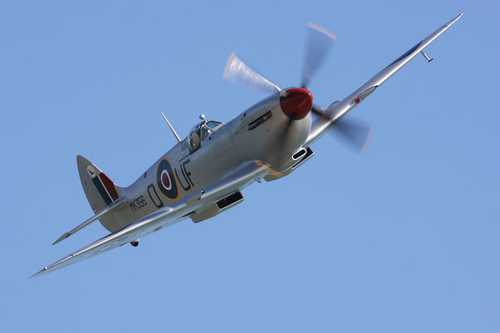
Modern/Post-War Photos
“Cab-rank” missions: a flying memorial
RAF BBMF
This all-silver Spitfire of the Battle of Britain Memorial Flight is a flying memorial to the Spitfire fighter-bombers pilots and their dangerous “cab-rank” operations. In effect this plane, the Spitfire Mk LFIX MK356, is painted to represent Spitfire Mk IX UF-0 MJ250 of 601 Squadron during the Italian campaign of 1944/45 when flew some “cab-rank” missions. According the RAF BBMF, the Spitfire Mk IX MJ250 was built by Vickers Armstrong in 1943, and was fitted with a Rolls Royce Merlin Mk 66 engine. It was delivered to the RAF in October 1943 and was shipped out to the Mediterranean theatre in the SS Fort George, leaving UK in December ’43. The Air Ministry Form 78 (the movement card) for this aircraft “dries up” after MJ250 arrived in theatre in early 1944 but the 601 Squadron operational records (Form 541) show that MJ250 was being flown by the Squadron from July 1944, whilst the unit was operating from the airfields at Perugia, Loreto and Fano. The aircraft was used primarily for dive-bombing operations in support of the Army’s advance up through Italy, although it also flew some bomber escort sorties. MJ250 survived the war but isn’t the BBMF’s plane because was scrapped after the peace’s return. The plane which represent the MJ250 is in reality the Spitfire LFIX MK356 (note the different fin and rudder) built at Castle Bromwich and allocated to 443 “Hornet” Squadron, Royal Canadian Air Force, at RAF Digby, Lincolnshire, in March 1944. MK356 soon moved with 144 Wing to Holmsley, near Bournemouth, then to Westhampnett (now Goodwood) and later to Ford in Sussex. The plane flew his first operational mission on 14 April 1944 as part of a “Rodeo” fighter sweep over occupied France, piloted by 20-year-old Canadian, Flying Officer “Gord” Ockenden, who flew 19 “ops” in the aircraft. From then on, MK356 was involved in fighter sweeps and in attacking ground targets by dive bombing and strafing in the lead-up to the D-Day invasion and in support of the landings and fierce fighting afterwards. In 60 days of furious flying and fighting, MK356 flew 60 operational sorties, was damaged by enemy fire on three occasions and suffered three wheels-up landings. On D-Day+1 (7 June 1944) during a beachhead cover patrol in MK356, “Gord” Ockenden’s flight engaged four Bf 109Gs “on the deck”. He fired at one of the ‘109’s and saw his rounds hitting the enemy aircraft. His wingman finished it off and each pilot was credited with a half share of the kill. On 14 June 1944 the aircraft’s third wheels-up landing of the war ended its short but intense operational life, as the next day the Squadron moved to airfield B-3 in France and MK356 was left behind to be collected and stored by a maintenance unit. Post war, MK356 was used as an instructional airframe at RAF Halton until 1951, and then for the next 17 years was a gate guardian at Hawkinge, Bicester, Locking and Henlow. MK356 featured as a static airframe in the film “Battle of Britain” in 1968 and then joined the RAF Museum Reserve Collection. In January 1992 a complete restoration to airworthy status was begun by a team from St Athan. The refurbishment was completed in November 1997 when the aircraft flew again for the first time in 53 years, subsequently joining the BBMF. Victor Sierra
2159 Views
12/9/2012
